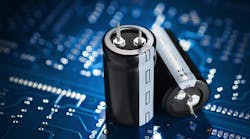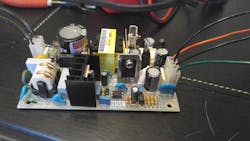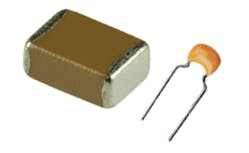Out of all of the fundamental passive electronic components, capacitors are arguably the most abundantly used. In fact, it is hard to find a circuit board that does not have a capacitor on it and a circuit that does not use a capacitor.
Capacitors play key roles in the design of filters, amplifiers, power supplies and many additional circuits. There are many different types of capacitors, each with its own advantages and disadvantages. The following paragraphs will review some of the important characteristics of different types of capacitors and their potential applications.
Figure 1. Multiple electrolytic capacitors.
All capacitors fundamentally do the same thing, which is that they store charge. Capacitance is a way to quantify or measure a capacitor’s ability to store charge. Capacitance is measured in Farads which is equivalent to one Coulomb per Volt or one Amp-Second per Volt (F=C/V=A*Sec/V). Farad is also a nod to the great British scientist Michael Faraday.
Most capacitors are available in leaded and unleaded packages. Surface mount components are the most commonly used. In fact, surface mount capacitors are so popular that there is an industry-wide shortage. For some applications involving high voltage and mains lines, through-hole components offer an advantage due to their higher capacitance and higher power handling abilities.
Capacitors are made up of different types of dielectric materials, including ceramic, electrolytic, tantalum, polyester, and polypropylene. The choice of materials obviously impacts key characteristics and performance.
Figure 2. Surface mount and leaded ceramic capacitors
Ceramic capacitors find use in all applications operating from DC to RF. They are capable of handling high voltages and generally have low equivalent series resistance (ESR) and equivalent series inductance (ESL). They are limited by their achievable capacitance value, but they do happen to be the least expensive type.
One the most widely used applications for ceramic capacitors is decoupling or bypassing on a power supply pin of an integrated circuit (IC), keeping any stray RF signals out of the voltage supply. Basically, the capacitor provides a low impedance path for the higher frequency signals to travel, which is a shunt path to ground. This keeps those signals from entering the IC and wreaking havoc and helps provide a more constant DC level of voltage. At times when the voltage supply may dip below the needed supply, the decoupling caps can temporarily provide the required voltage.
On the other hand, electrolytic capacitors are capable of providing engineers with a much higher capacitance value. These capacitors can be found in many power electronics and in circuits with high amounts of power consumption. One example where electrolytics offer an advantage is the reservoir capacitor in power supplies.
Figure 3. Meanwell power supply with multiple types of capacitors
In the picture shown above, the reservoir capacitor is shown in the upper left. Its purpose is to smooth out the rectified voltage from the power lines. Some level of ripple remains after this smoothing function, and as a result, the capacitor must have a sufficient ripple current rating. The ripple current includes the capacitor discharge current and the capacitor charging current. These capacitors generally are a very large value and also must be chosen to have a much larger time constant than the AC line’s frequency. Consideration must be taken here to avoid using a capacitor that is too large or too costly.
Like electrolytics, tantalum capacitors are generally polarized and offer lower leakage currents. Due to the tantalum material used in their construction, they can offer higher capacitance values in smaller package sizes than other choices. They also have better stability characteristics, meaning their capacitance is less likely to change over time. Disadvantages include a higher price and also the way they can fail.
When electrolytics fail, they tend to fail open. In other words, they appear to become an open circuit. When tantalum capacitors fail, they tend to create a short circuit and in some instances can even burn. Consequently, using them responsibly requires fail-safe circuits to prevent any damage to the circuits. Tantalum capacitors find use in many military and medical applications.
In conclusion, capacitors are one of the most widely used electrical components. When designing circuits, the choice of capacitor must not be overlooked. Characteristics such as voltage rating, ripple current rating, size and cost must always be taken into consideration.
To help with capacitor selection, many manufacturers offer online tools available to help navigate and find the right capacitor for the application. It is wise to use these tools as they will simplify the selection process. Just as there is a right tool for every job, there is a right capacitor for every application.



